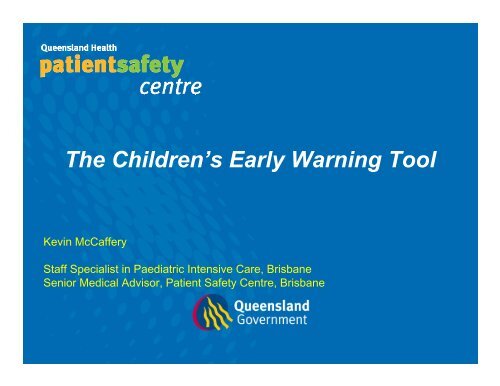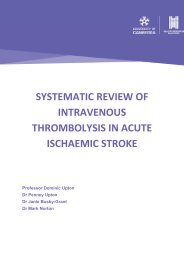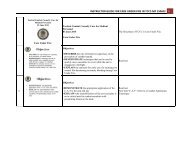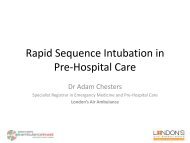The-Children-s-Early-Warning-Tool
The-Children-s-Early-Warning-Tool
The-Children-s-Early-Warning-Tool
You also want an ePaper? Increase the reach of your titles
YUMPU automatically turns print PDFs into web optimized ePapers that Google loves.
<strong>The</strong> <strong>Children</strong>’s <strong>Early</strong> <strong>Warning</strong> <strong>Tool</strong><br />
Kevin McCaffery<br />
Staff Specialist in Paediatric Intensive Care, Brisbane<br />
Senior Medical Advisor, Patient Safety Centre, Brisbane
Objective<br />
• To design a suite of tools to meet the needs of<br />
bedside clinicians<br />
• Observation chart<br />
• Reference ranges for age<br />
• <strong>Early</strong> warning score<br />
• Clinical escalation<br />
• <strong>Tool</strong> to assess interventions<br />
• Triage tool<br />
• Customisable
Design<br />
• Blank canvas<br />
• What observations predict deterioration?<br />
• Normal ranges for age?<br />
• Single point vs. cumulative score? (both…?)<br />
• Weighting of observations<br />
• What observations – pragmatic<br />
• Human factors approach to design
Validation<br />
• Retrospective<br />
• All patients admitted PICU from ward in 2007<br />
• CEWT detected patients before PICU admission<br />
• Prospective<br />
• Twelve pilot sites (tertiary / regional / rural)<br />
• Two month trial<br />
• Phased roll-out<br />
• Retrieval population<br />
• Root Cause Analysis<br />
• Semi-qualitative implementation study
Retrospective validation<br />
ICU admissions<br />
11<br />
10<br />
9<br />
8<br />
bronchiolitis n=20<br />
pneumonia n=5<br />
reactive airways n=4<br />
sepsis n=14<br />
CEWT score<br />
7<br />
6<br />
5<br />
4<br />
3<br />
2<br />
1<br />
0<br />
-48 -45 -42 -39 -36 -33 -30 -27 -24 -21 -18 -15 -12 -9 -6 -3 0<br />
time (hours)
CEWT – Bronchiolitis<br />
ICU admissions: bronchiolitis<br />
8<br />
7<br />
6<br />
CEWT score<br />
5<br />
4<br />
3<br />
2<br />
1<br />
0<br />
-48 -45 -42 -39 -36 -33 -30 -27 -24 -21 -18 -15 -12 -9 -6 -3 0<br />
time (hours)
10<br />
9<br />
8<br />
7<br />
6<br />
5<br />
4<br />
3<br />
2<br />
1<br />
0<br />
CEWT – Bronchiolitis controls<br />
Bronchiolitis - Controls<br />
Bronchiolitis - Controls<br />
183<br />
12<br />
21<br />
30<br />
39<br />
48<br />
57<br />
66<br />
75<br />
84<br />
93<br />
102<br />
111<br />
120<br />
129<br />
138<br />
147<br />
156<br />
165<br />
174<br />
time (hours)<br />
3
Prospective trial<br />
• Approximately 1900 patients<br />
• Currently analysing data<br />
• Optimise physiological weighting<br />
• Optimise action box (for different institutional capabilities)<br />
• Impression is that scoring seems appropriate<br />
• Two critical incidents<br />
• Patients had respiratory arrests<br />
• In both cases, CEWT had been overruled by registrar
Maximum CEWT score<br />
600<br />
500<br />
400<br />
n =1886<br />
Patients<br />
300<br />
200<br />
100<br />
83%<br />
0<br />
0 1 2 3 4 5 6 7 8 9 10 11 12 13<br />
CEWT score
CEWT scores by centre<br />
Patients<br />
160<br />
140<br />
120<br />
100<br />
80<br />
60<br />
40<br />
20<br />
0<br />
0 1 2 3 4 5 6 7 8 9 10 11 12 13<br />
CEWT score<br />
Tertiary<br />
Regional 1<br />
Regional 2<br />
Regional 3<br />
Regional 4<br />
Regional 5<br />
Rural
Bronchiolitis: Index vs. Controls<br />
CEWT score<br />
9<br />
8<br />
7<br />
6<br />
5<br />
4<br />
3<br />
2<br />
1<br />
0<br />
Prospective<br />
Retrospective controls<br />
Retrospective index<br />
*<br />
0 3 6 9 12 15 18 21 24 27 30 33 36 39 42 45 48 51 54 57 60<br />
time (hours)
Respiratory Rate: Index vs. Controls<br />
80<br />
CEWT score<br />
70<br />
60<br />
50<br />
40<br />
30<br />
20<br />
10<br />
0<br />
Retrospective Controls<br />
Retrospective Index<br />
1 6 11 16 21 26 31 36 41 46 51 56 61<br />
Hours<br />
*
Retrieval CEWT<br />
• 4 month convenience sample of retrieval referrals<br />
• Evaluate state-wide implemetation<br />
• Identify early and late referrers<br />
• Improve objectivity in co-ordination
Retrieval patients - CEWT score<br />
50<br />
45<br />
40<br />
35<br />
30<br />
25<br />
20<br />
15<br />
10<br />
5<br />
0<br />
n = 204<br />
23%<br />
51%<br />
0 1 2 3 4 5 6 7 8 9 10 11 12 13
CEWT score by diagnostic group<br />
25<br />
20<br />
15<br />
Trauma<br />
Resp infection<br />
Sepsis<br />
Seizure<br />
Gen Surgery<br />
Asthma<br />
DKA<br />
10<br />
5<br />
0<br />
0 1 to 3 4,5 6,7 ³ 8
Retrieval team composition vs. CEWT<br />
30<br />
25<br />
Nurse / ICP<br />
Doctor / nurse<br />
20<br />
15<br />
10<br />
5<br />
0<br />
0 1 2 3 4 5 6 7 8 9 10 11 12 13<br />
CEWT score
Root Cause Analysis<br />
• Currently reviewing state-wide data in last 3 years<br />
• 20 cases filed (RCAs not total deaths)<br />
• 1 late identification spinal injury<br />
• 2 – haemorrhage during / post surgery<br />
• 1 out-of-hospital arrest (discharged that day)<br />
• 1 SUDEP
Semi-quantitative implementation study<br />
• Questionnaire at end of prospective trial period<br />
• Evaluation of trial-site experience<br />
• Staff demographics<br />
• Impact on perceived ability to care for hospitalised children<br />
• Ease of use<br />
• Educational material / support<br />
• Inform design of state-wide implementation strategy
<strong>Children</strong>'s <strong>Early</strong> <strong>Warning</strong> <strong>Tool</strong> - Respondents<br />
50<br />
45<br />
40<br />
35<br />
n = 115<br />
30<br />
25<br />
20<br />
15<br />
10<br />
5<br />
0<br />
Paed Nurse<br />
3yr<br />
Adult / Paed<br />
Nurse<br />
Paed<br />
resident<br />
Paed<br />
registrar<br />
Paed<br />
consultant<br />
GP
What impact has CEWT had on your ability to care for children<br />
in hospital?<br />
5<br />
Improved<br />
4.5<br />
4<br />
3.5<br />
3<br />
No change<br />
2.5<br />
2<br />
1.5<br />
1<br />
Tertiary<br />
HDU<br />
Tertiary<br />
Oncology<br />
Tertiary<br />
Medical /<br />
Surgical<br />
Regional<br />
1<br />
Regional<br />
2<br />
Regional<br />
3<br />
Regional<br />
4<br />
Regional<br />
5<br />
Rural 1 Rural 2 Rural 3 Rural 4 Rural 5<br />
Worsened
Very easy<br />
Very hard<br />
Rural 5<br />
5<br />
4.5<br />
4<br />
3.5<br />
3<br />
2.5<br />
2<br />
1.5<br />
1<br />
How difficult was the CEWT chart to use?<br />
Regional 1<br />
Regional 2<br />
Regional 3<br />
Regional 4<br />
Regional 5<br />
Rural 1<br />
Rural 2<br />
Rural 3<br />
Rural 4<br />
Tertiary Medical / Surgical<br />
Tertiary Oncology<br />
Tertiary HDU
How did you rate the educational material and support?<br />
5<br />
Excellent<br />
4.5<br />
4<br />
3.5<br />
3<br />
Acceptable<br />
2.5<br />
2<br />
1.5<br />
1<br />
Tertiary<br />
HDU<br />
Tertiary<br />
Oncology<br />
Tertiary<br />
Medical /<br />
Surgical<br />
Regional<br />
1<br />
Regional<br />
2<br />
Regional<br />
3<br />
Regional<br />
4<br />
Regional<br />
5<br />
Rural 1 Rural 2 Rural 3 Rural 4 Rural 5<br />
Poor
What next…<br />
• Complete prospective analysis<br />
• Optimise CEWT<br />
• Design state-wide implementation<br />
• Work collaboratively across borders<br />
• Further projects<br />
• Other charts<br />
• Telemedicine<br />
• Computers
Acknowledgements<br />
• <strong>The</strong> staff of the Patient Safety Centre, Brisbane<br />
• John Wakefield, Jillann Farmer, Rowena Richardson,<br />
Hayden Scotter, Lynette Adams<br />
• <strong>The</strong> other members of the CEWT team<br />
• Jo-Anne Stephens<br />
• Ruth McCaffery<br />
• <strong>The</strong> staff who participated in the prospective trial





